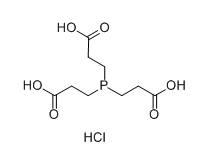Upgraded products and alternative solutions for the application of TCEP-HCl [Tris(2-carboxyethyl)phosphine hydrochloride] - DTT (Dithiothreitol).
Time:2024-03-11 Hits:195
TCEP-HCl [tris(2-carboxyethyl)phosphine hydrochloride] is a water-soluble, odorless disulfide bond reducing agent extensively employed in biochemistry and molecular biology for the reduction of disulfide bonds in peptides or proteins.
Basic Information:
Product Name: TCEP-HCl (Tris(2-carboxyethyl)phosphorus hydrochloride)
Item Number: DJL0145B
CAS Number: 51805-45-9
Molecular Formula: C9H16ClO6P
Molecular Weight: 286.647
Item Number: DJL0145B
CAS Number: 51805-45-9
Molecular Formula: C9H16ClO6P
Molecular Weight: 286.647

Upgraded Product and DTT Alternative:
TCEP-HCl serves as an advanced and odorless disulfide bond reducing agent, providing a superior alternative to DTT (dithiothreitol) in biochemistry and molecular biology applications. With upgraded features, it enhances the efficiency and convenience of disulfide bond reduction for peptides and proteins.
Comparison of TCEP-HCl and DTT (dithiothreitol)
|
Prroducts
|
DTT
|
TCEP-HCl
|
|
odor
|
slight sulfur smell
|
odorless
|
|
water solubility
|
50g/L ;
|
310g/L ;
|
|
Reducibility
|
Lasts 3-7 days
|
Lasts 2-3 weeks
|
|
stability
|
Weak volatility, minimize exposure time to air, oxidize quickly in the presence of Ni2+
|
Non-volatile, resistant to air oxidation; not affected by metal ions.
|
|
pH working range
|
6.5-9.0
|
1.5-8.5
|
|
working concentration
|
1-100mM ;
|
5-50mM (most systems)
|
|
Ni2+ column purification of His-tagged proteins
|
Not applicable
|
Applicable
|
|
Maleimide labeled protein reaction
|
Requires removal prior to marking.
|
Does not require removal before marking.
|
Prior to labeling, TCEP-HCl requires removal, presenting numerous advantages over DTT:
1 No Peculiar Smell: TCEP-HCl is odorless and can be used without the need for a fume hood.
2 High Stability: It maintains stability without concerns of oxidation during operation, use, and storage.
3 Wide pH Working Range: TCEP-HCl is effective across a broad pH range.
4 Strong Reducing Properties: In most experiments, 5-50mM TCEP-HCl offers significant molar force for complete disulfide bond reduction at room temperature within minutes.
5 Wide Compatibility: TCEP-HCl lacks thiol groups, eliminating the need for pre-removal in downstream thiol modification experiments like maleimide coupling.
Applications:
Gel Electrophoresis and Metal Ion Affinity Chromatography (IMAC): Used in preparation steps as a reducing agent to disrupt disulfide bonds within or between proteins.
Maleimide Coupling Reaction: Employed in coupling reactions with cysteine residues to prevent disulfide bond formation, unlike DTT or β-ME, ensuring efficient amine reactions with maleimide.
Homocysteine Measurement Kits: Utilized as a reducing agent to convert oxidized homocysteine into free homocysteine.
Quality Index
|
SPECIFICATION
|
STANDARD
|
|
Appearance
|
white crystal
|
|
Assay %
|
≥98.0
|
|
MP ℃
|
170.0-180.0
|
Preservation Method:
Store at 2-8℃, away from light and moisture, ensuring optimal stability.
For more product details, please contact us: service@seebio.cn or Phone: +86 21 58183719 or Wechat: +86 158 0195 7578
Ordering information
|
Item number
|
Product name
|
Packaging specifications
|
|
DJL0145B
|
Tris(2-carbonylethyl)phosphate hydrochloride (TCEP-HCl)
|
5g, 25g, 100g, 500g, 1Kg
|
Related Products
|
Item number
|
Product name
|
Packaging
|
|
DAA0291A
|
S-adenosylmethionine (SAM)
|
5g
|
|
ECI0078A
|
NADH
|
1g
|
|
DLA0012A
|
alpha-ketoglutarate
|
500g
|
|
ECE1042A
|
Hcy methyltransferase (HMTase)
|
1mg
|
|
ECE0134A
|
glutamate dehydrogenase (GLDH)
|
50KU
|
|
ECE1043A
|
S-adenosylhomocysteine (SAH) hydrolase (SAHase)
|
1mg
|
|
ECE0128A
|
Adenosine dehydrogenase (ADA)
|
1KU
|
References
[1] Getz, EB, et al. 1999. Anal. Biochem. 273, 73.
[2] Atpase activity of Mycobacterium tuberculosis SecA1 and SecA2 proteins and its importance for SecA2 function in macrophages Hou JM et al. J Bacteriol (2008) 190:4880-7 Krezel A, et al. Inorganic Chemistry 42(6), 1994-2003, (2003)
[3] Grubbs, R. ;H. ;Org. ;React. ;22, ;123-123, ;(2004)
[4] Chang Liangang, Zhao Jing, Ren Feng, etc. Determination of plasma homocysteine by circulating enzymatic method[J]. laboratory medicine,2007,22(1):1619
[5] Methodological evaluation of circulating enzyme method for determination of plasma homocysteine [J] Chinese Journal of Health Inspection, Issue 06, 2010 5 Ouyang Xuan; Hu Liping
[2] Atpase activity of Mycobacterium tuberculosis SecA1 and SecA2 proteins and its importance for SecA2 function in macrophages Hou JM et al. J Bacteriol (2008) 190:4880-7 Krezel A, et al. Inorganic Chemistry 42(6), 1994-2003, (2003)
[3] Grubbs, R. ;H. ;Org. ;React. ;22, ;123-123, ;(2004)
[4] Chang Liangang, Zhao Jing, Ren Feng, etc. Determination of plasma homocysteine by circulating enzymatic method[J]. laboratory medicine,2007,22(1):1619
[5] Methodological evaluation of circulating enzyme method for determination of plasma homocysteine [J] Chinese Journal of Health Inspection, Issue 06, 2010 5 Ouyang Xuan; Hu Liping